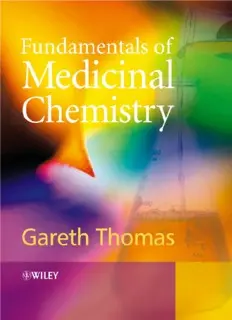
Fundamentals of Medicinal Chemistry By Gareth Thomas PDF
Preview Fundamentals of Medicinal Chemistry By Gareth Thomas
Fundamentals of Medicinal Chemistry Gareth Thomas University of Portsmouth, UK Fundamentals of Medicinal Chemistry Fundamentals of Medicinal Chemistry Gareth Thomas University of Portsmouth, UK Copyright#2003byJohnWiley&SonsLtd, TheAtrium,SouthernGate,Chichester, WestSussexPO198SQ,England National 01243779777 International(þ44)1243779777 e-mail(forordersandcustomerserviceenquiries):[email protected] VisitourHomePageonhttp://www.wiley.co.ukorhttp://www.wiley.com Allrightsreserved.Nopartofthispublicationmaybereproduced,storedinaretrievalsystem,or transmitted,inanyformorbyanymeans,electronic,mechanical,photocopying,recording, scanningorotherwise,exceptunderthetermsoftheCopyright,DesignsandPatentsAct1988or underthetermsofalicenceissuedbytheCopyrightLicensingAgency,90TottenhamCourt Road,London,UKW1P9HE,withoutthepermissioninwritingofthepublisher. OtherWileyEditorialOffices JohnWiley&Sons,Inc.,605ThirdAvenue, NewYork,NY10158–0012,USA Wiley-VCHVerlagGmbH,Pappelallee3, D-69469Weinheim,Germany JohnWiley&Sons(Australia)Ltd,33ParkRoad,Milton, Queensland4064,Australia JohnWiley&Sons(Asia)PteLtd,2ClementiLoop#02–01, JinXingDistripark,Singapore0512 JohnWiley&Sons(Canada)Ltd,22WorcesterRoad, Rexdale,OntarioM9W1L1,Canada Wileyalsopublishesitsbooksinavarietyofelectronicformats.Somecontentthatappearsin printmaynotbeavailableinelectronicbooks LibraryofCongressCataloging-in-PublicationData Thomas,Gareth,Dr. Fundamentalsofmedicinalchemistry/GarethThomas. p.cm. Includesbibliographicalreferencesandindex. ISBN0-470-84306-3(cloth:alk.paper) ISBN0-470-84307-1(paper:alk.paper) 1.Pharmaceuticalchemistry. I.Title. RS403.T4462003 615’.19——dc21 2003014218 BritishLibraryCataloguinginPublicationData AcataloguerecordforthisbookisavailablefromtheBritishLibrary ISBN0-470843063(Hardback) ISBN0-470843071(Paperback) Typesetin11/14ptTimesbyKolamInformationServicesPvt.Ltd,Pondicherry,India PrintedandboundinGreatBritainbyAntonyRoweLtd Thisbookisprintedonacid-freepaperresponsiblymanufacturedfromsustainableforestry, inwhichatleasttwotreesareplantedforeachoneusedforpaperproduction. Contents Preface xi Acknowledgements xii Abbreviations/Acronyms xiii 1 Biological Molecules 1 1.1 Introduction 1 1.2 Aminoacids 1 1.2.1 Introduction 1 1.2.2 Structure 3 1.2.3 Nomenclature 3 1.3 Peptidesandproteins 4 1.3.1 Structure 6 1.4 Carbohydrates 10 1.4.1 Thestructureofmonosaccharides 11 1.4.2 Thenomenclatureofmonosaccharides 14 1.4.3 Glycosides 15 1.4.4 Polysaccharides 17 1.4.5 Thenomenclatureofpolysaccharides 18 1.4.6 Naturallyoccurringpolysaccharides 18 1.5 Lipids 20 1.5.1 Introduction 20 1.5.2 Fattyacids 20 1.5.3 Acylglycerols(glycerides) 21 1.5.4 Steroids 21 1.5.5 Terpenes 22 1.5.6 Phospholipids 23 1.5.7 Glycolipids 25 1.6 Nucleicacids 26 1.6.1 Introduction 26 1.6.2 DNA,structureandreplication 28 1.6.3 Genesandthehumangenomeproject 30 1.6.4 RNA,structureandtranscription 31 1.6.5 ClassificationandfunctionofRNA 33 1.7 Questions 34 2 An Introduction to Drugs and their Action 37 2.1 Introduction 37 2.2 Whataredrugsandwhydoweneednewones? 37 2.3 Drugdiscoveryanddesign,ahistoricaloutline 39 2.4 Sourcesofdrugsandleadcompounds 43 vi CONTENTS 2.4.1 Naturalsources 43 2.4.2 Drugsynthesis 45 2.4.3 Marketforcesand‘me-toodrugs’ 45 2.5 Classificationofdrugs 45 2.6 Routesofadministration,thepharmaceuticalphase 46 2.7 Introductiontodrugaction 49 2.7.1 Thepharmacokineticphase 49 Absorption 49 Distribution 50 Metabolism 51 Eliminination 51 2.7.2 Bioavailabilityofadrug 53 2.7.3 Thepharmacodynamicphase 53 2.8 Questions 55 3 An Introduction to Drug Discovery 57 3.1 Introduction 57 3.2 Stereochemistryanddrugdesign 59 3.2.1 Structurallyrigidgroups 59 3.2.2 Conformation 60 3.2.3 Configuration 60 3.3 Solubilityanddrugdesign 61 3.3.1 Theimportanceofwatersolubility 62 3.4 Solubilityanddrugstructure 63 3.5 Saltformation 64 3.6 Theincorporationofwatersolubilizinggroupsinastructure 65 3.6.1 Thetypeofgroup 66 3.6.2 Reversiblyandirreversiblyattachedgroups 66 3.6.3 Thepositionofthewatersolubilizinggroup 67 3.6.4 Methodsofintroduction 67 3.7 Questions 70 4 The SAR and QSAR Approaches to Drug Design 71 4.1 Structure–activityrelationships(SARs) 71 4.2 Changingsizeandshape 73 4.3 Introductionofnewsubstituents 73 4.3.1 Theintroductionofagroupinanunsubstituted position 73 4.3.2 Theintroductionofagroupbyreplacingan existinggroup 76 4.4 Quantitativestructure–activityrelationships(QSARs) 78 4.4.1 Lipophilicity 79 Partitioncoefficients(P) 79 Lipophilicsubstitutionconstants(p) 80 4.4.2 Electroniceffects 82 TheHammettconstant(s) 82 4.4.3 Stericeffects 83 TheTaftstericparameter(E) 84 s Molarrefractivity(MR) 84 Otherparameters 85 CONTENTS vii 4.4.4 Hanschanalysis 85 Craigplots 88 4.5 TheToplissdecisiontree 89 4.6 Questions 92 5 Computer Aided Drug Design 95 5.1 Introduction 95 5.1.1 Molecularmodellingmethods 96 5.1.2 Computergraphics 98 5.2 Molecularmechanics 98 5.2.1 Creatingamolecularmodelusingmolecularmechanics 102 5.3 Moleculardynamics 104 5.3.1 Conformationalanalysis 105 5.4 Quantummechanics 105 5.5 Docking 109 5.6 Questions 110 6 Combinatorial Chemistry 113 6.1 Introduction 113 6.1.1 Thedesignofcombinatorialsyntheses 115 6.1.2 Thegeneraltechniquesusedincombinatorialsynthesis 116 6.2 Thesolidsupportmethod 117 6.2.1 Parallelsynthesis 118 6.2.2 Furka’smixandsplittechnique 121 6.3 Encodingmethods 123 6.3.1 Sequentialchemicaltaggingmethods 123 6.3.2 Still’sbinarycodetagsystem 124 6.3.3 Computerizedtagging 126 6.4 Combinatorialsynthesisinsolution 127 6.5 Screeninganddeconvolution 128 6.6 Questions 130 7 Selected Examples of Drug Action at some Common Target Areas 131 7.1 Introduction 131 7.2 Examplesofdrugsthatdisruptcellmembranesandwalls 131 7.2.1 Antifungalagents 132 Azoles 133 Allylamines 134 Phenols 135 7.2.2 Antibacterialapents 135 Ionophoricantibioticaction 135 Cellwallsynthesisinhibition 136 7.3 Drugsthattargetenzymes 138 7.3.1 Reversibleinhibihors 139 7.3.2 Irreversibleinhibition 140 7.3.3 Transitionstateinhibitors 142 7.4 Drugsthattargetreceptors 144 7.4.1 Agonists 144 7.4.2 Antagonists 145 7.4.3 Partialagonists 147
